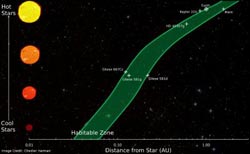Researchers develop model for identifying habitable zones around star

The graphic shows habitable zone distances around various types of stars. Some of the known extrasolar planets that are considered to be in the habitable zone of their stars are also shown. On this scale, Earth-Sun distance is one astronomical unit, which is roughly 150 million kilometers. Click on the image for a higher resolution version.<br><br>Credit: Chester Herman<br>
Using the latest data, the Penn State Department of Geosciences team has developed an updated model for determining whether discovered planets fall within a habitable zone. The work builds on a prior model by James Kasting, Evan Pugh Professor of Geosciences at Penn State, to offer a more precise calculation of where habitable zones around a star can be found.
Comparing the new estimates with the previous model, the team found that habitable zones are actually farther away from the stars than previously thought.
“This has implications for finding other planets with life on them,” said post-doctoral researcher Ravi kumar Kopparapu, a lead investigator on the study, which will be published described in Astrophysical Journal.
For the paper, Kopparapu and graduate student Ramses Ramirez used updated absorption databases of greenhouse gases (HITRAN and HITEMP). The databases have more accurate information on water and carbon dioxide than previously was available and allowed the research team to build new estimates from the groundbreaking model Kasting created 20 years ago for other stars.
Using that data and super computers at Penn State and the University of Washington, the team was able to calculate habitable zones around other stars. In the previous model, water and carbon dioxide were not being absorbed as strongly, so the planets had to be closer to the star to be in the habitable zone.
The new model has already found that some extrasolar planets previously believed to be in habitable zones may, in fact, not be.
The new model could also help scientists with research that is already under way. For example, the model could be used to see if planets the NASA Kepler mission discovers are within a habitable zone. The Kepler mission has found more than 2,000 potential systems that could be investigated.
The data could assist with a Habitable Zone Planet Finder a team of scientists in Penn State's Department of Astronomy and Astrophysics is building. In 2011, that team received a National Science Foundation grant to develop an instrument to find planets in habitable zones. The precision spectrograph, which is under construction, will help scientists find Earth-sized planets in the Milky Way that could sustain liquid water.
In the future, the model could also be useful for research done with Terrestrial Planet Finder telescopes, which would guide users of the supersized telescopes on where to look.
While in the new model Earth appears to be situated at the very edge of the habitable zone, the model doesn't take into account feedback from clouds, which reflect radiation away from the earth and stabilize the climate.
In addition to Kopparapu, Ramirez and Kasting, researchers on the project are: Vincent Eymet, Laboratoire d'Astrophysique de Bordeaux at the Universite de Bordeaux; Tyler D. Robinson and Victoria Meadows, University of Washington; Suvrath Mahadevan, Ryan C. Terrien and Rohit Deshpande, Penn State; and Shawn Domagal-Goldman, NASA Goddard Space Flight Center.
Support for the research comes from NASA Astrobiology Institute's Virtual Planetary Laboratory. An interactive calculator to estimate Habitable Zones is online: depts.washington.edu/naivpl/content/hz-calculator.
The paper is available online at: http://arxiv.org/abs/1301.6674
Media Contact
More Information:
http://www.psu.eduAll latest news from the category: Physics and Astronomy
This area deals with the fundamental laws and building blocks of nature and how they interact, the properties and the behavior of matter, and research into space and time and their structures.
innovations-report provides in-depth reports and articles on subjects such as astrophysics, laser technologies, nuclear, quantum, particle and solid-state physics, nanotechnologies, planetary research and findings (Mars, Venus) and developments related to the Hubble Telescope.
Newest articles

Silicon Carbide Innovation Alliance to drive industrial-scale semiconductor work
Known for its ability to withstand extreme environments and high voltages, silicon carbide (SiC) is a semiconducting material made up of silicon and carbon atoms arranged into crystals that is…

New SPECT/CT technique shows impressive biomarker identification
…offers increased access for prostate cancer patients. A novel SPECT/CT acquisition method can accurately detect radiopharmaceutical biodistribution in a convenient manner for prostate cancer patients, opening the door for more…

How 3D printers can give robots a soft touch
Soft skin coverings and touch sensors have emerged as a promising feature for robots that are both safer and more intuitive for human interaction, but they are expensive and difficult…





















